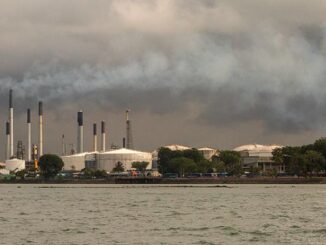
PAGE, Arizona, December 19, 2020 (ENS) – For 45 years the Navajo Generating Station was the largest coal-fired power plant in the western United States – a 2.25-gigawatt facility located on the Navajo Nation, near Lake Powell in Arizona that spread air pollution far and wide. In November 2019, the plant ended commercial generation, and on Friday, its three tall smokestacks all went down in smoke.

The Navajo Generating Station’s smokestacks, as tall as a 77 story-building, were demolished in a single explosive blast. In addition to the stacks, the 199-foot high steel-frame Unit 3 electro-static precipitator, which captured fly ash so it would not be emitted into the atmosphere, was simultaneously demolished.
In 2017, the Salt River Project, the majority owners and operators of the power station voted to close the facility when the lease expired in 2019 due to rising operating costs. In March 2019, the Navajo Nation ceased its efforts to buy the plant and continue running it.
Demolition of the smokestacks marks the end of the region’s reliance on coal now that renewable energy sources like solar, wind and natural gas have become less costly. Decommissioning of the site is expected to be complete by the end of 2022.
“It’s been known for a long time that coal isn’t the future, but this final certainty is crucial. For anyone who’s been hesitant about moving strongly for renewable energy development, for building our economy in ways that will benefit our communities and our Mother Earth and Father Sky, now there is no reason or excuse to hold back,” said Lori Goodman of the Navajo nonprofit energy and environmental group Diné CARE in March 2019.
This plant on the Arizona-Utah border provided electrical power to customers in Arizona, Nevada, and California, and it also provided the power for pumping Colorado River water for the Central Arizona Project, supplying about 1.5 million acre-feet of water annually to central and southern Arizona.
Owners of the Navajo Generating Station include the U.S. Bureau of Reclamation, the Salt River Project, Arizona Public Service Co., NV Energy, the Los Angeles Department of Water & Power and Tucson Electric Power Company.
The Kayenta coal mine, which fed the plant, closed in August 2019 as it had no other customers besides the Navajo Generating Station. Jobs at the coal mine and at the power plant paid well and 90 percent of the plant’s employees were Navajo, so decommissioning of the facility has left them without those jobs.
Critics of the facility cite its environmental costs as it consumed nearly 22,000 tons of coal and emitted 44,000 tons of carbon dioxide every day.
“Every hour the Navajo’s generators spin, the plant spews more climate-warming gases into the atmosphere than almost any other single facility in the United States. Alone, it accounts for 29 percent of Arizona’s emissions from energy generation. The Navajo station’s infernos gobble 15 tons of coal each minute, 24 hours each day, every day,” wrote Abrahm Lustgarten of ProPublica in June 2015.
“In my many years as a civil engineer, I have never witnessed such a powerful, historic and epic event,” said Gary Barras, Salt River Project director of Project Management and Construction. “In just 54 seconds, three monumental giants toppled, the earth trembled and the skylines visible from spectacular Lake Powell, Antelope and Glen canyons changed forever.”
In a statement Friday, the Navajo and Hopi tribes welcomed the demolition, even though the plant had supported good-paying jobs in their communities.
“The demolition of the smokestacks at NGS is a solemn event,” said Nicole Horseherder, executive director of the Navajo environmental grassroots group Tó Nizhóní Ání. “It’s a reminder of decades of exploitation subsidized by cheap coal and water from the Navajo and Hopi.”
Horseherder explained that those jobs for tribal members resulted in respiratory ailments for tribal coal miners and a land contaminated by polluted water. Also, many Navajo and Hopi tribal members could not even access the electricity and water the plant produced as most of it went to the nearby city of Phoenix, Arizona.

Now that the station is no longer functioning, some Navajo and Hopi members think the future will be better without the coal-fired plant.
“We’re hopeful that this marks the continuation of our transformation into a sustainable economy that is built on fundamental Navajo and Hopi respect for air, land and water and that will have direct, measurable benefits for our communities, not exploit them,” Carol Davis, director of Diné CARE, said in the statement.
Before closure, the Salt River Project, SRP, offered new positions within the company to all 433 regular generating station employees. Nearly 300 accepted offers for redeployment to other SRP positions. SRP also instructed contractors conducting decommissioning operations to extend hiring preference for contract work to qualified members of the Navajo Nation.
The Salt River Project now must complete the complex, costly process of clearing the rest of the power plant’s infrastructure and returning the land to its original state. SRP estimates that more than 90 percent of the decommissioned plant will be salvageable.
The Navajo Nation has elected to retain some facilities at the plant including the warehouse and maintenance buildings, lake pump system and railroad that are valued at around $175 million. The owners also paid nearly $19 million to the Navajo Nation for cost savings associated with not decommissioning those facilities and paid $3.6 million to fund a solid waste disposal program for the nation.
In addition to extending operations at the generating station for nearly three years to ensure a transition period for the nation and plant employees, the owners agreed to a 35-year extension lease that will provide lease payments totaling about $110 million to the Navajo Nation and will allow continued access to the site for decommissioning, long-term monitoring and ongoing operation of the transmission system.
The federal government has promised to provide 500 megawatts of transmission capacity from the Navajo Generating Station transmission station valued at more than $80 million. The NGS owners will pay the Navajo Nation’s share of operations and maintenance costs at the station for 10 years, at a project value of $5 million.
Copyright Environment News Service (ENS) 2020. All rights reserved.



